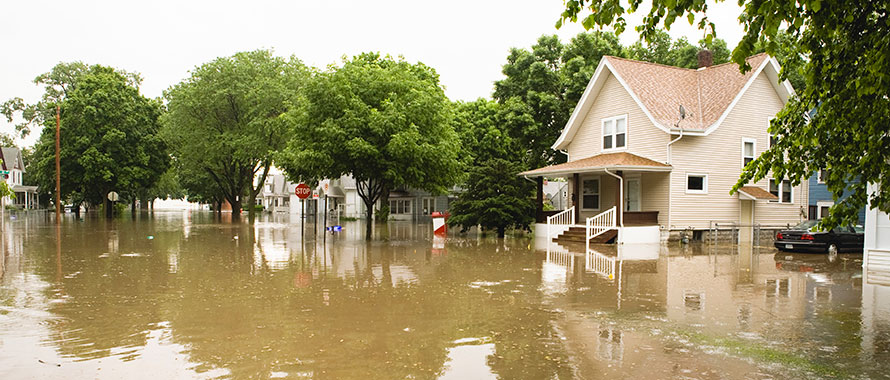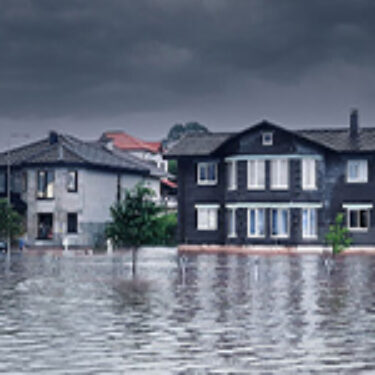At least 22 individuals were killed and many more remained missing after a flash flood ravaged the rural town of Waverly, Tennessee on Aug. 21. The sudden torrent of rain — estimated at 17 inches, likely setting a state record — swept away vehicles, tore homes off their foundations and crumbled roads and bridges. By Aug. 23, officials were reportedly continuing to search for at least 50 residents who were still missing.
“This was a catastrophic flood,” said Brad Turner, Associate Vice President, National Product Manager, Flood, Burns & Wilcox, Morehead City, North Carolina. “It is devastating from a loss of life standpoint, and loss of property as well. When you have 17 inches of water in a one-day period, there is a lot of force behind that, and nobody had any warning. They were caught off guard.”
The Northeast also faced flash flooding last weekend when tropical storm Henri made landfall after being downgraded from a Category 1 hurricane. The storm, which was later further downgraded to a tropical depression, evacuated towns and flooded neighborhoods throughout New England and left tens of thousands in the region without power.

The tricky thing with flood zones is that they really just show you what could happen in a 100-year period or 500-year period. Every single year, though, we are proving that these events are starting to occur outside of the norm of what you would expect.
Flood risk is increasing in both the U.S. and Canada as climate change fuels more severe weather events, experts say, and homeowners should be prepared by having emergency evacuation plans in place and purchasing Flood Insurance when necessary.1,2,3
“The sad fact of it is that these types of flooding events happen all the time,” said Jacob Martin, Senior Underwriter, Flood, Burns & Wilcox, Morehead City, North Carolina. “It does not detract from the emotional weight that they bring and the devastation they have on individuals’ lives, but it is important to know that they happen regularly, unfortunately.”
Misconceptions about risk drive more homeowners to be uninsured for flood
On Aug. 24, President Joe Biden approved a disaster declaration for Tennessee to help with flood recovery efforts.4 This includes federal funding that can provide assistance such as temporary housing grants and low-interest loans for uninsured property losses, the Tennessean reported. In March, after rainfall brought damaging floodwaters to Middle Tennessee, it was reported that the majority of homeowners in this area did not have Flood Insurance.5 This type of coverage is available through private insurance carriers or FEMA’s National Flood Insurance Program (NFIP).
A standard Homeowners Insurance policy will not cover flood losses, Turner noted, and many home-buyers only purchase Flood Insurance when it is required by their mortgage lender based on the home’s location in a high-risk flood zone.6 However, FEMA reported in June that more than 25% of flood claims in the U.S. came from outside of high-risk zones.7
“The tricky thing with flood zones is that they really just show you what could happen in a 100-year period or 500-year period,” he explained. “Every single year, though, we are proving that these events are starting to occur outside of the norm of what you would expect. It is a testament to the impact that climate change is having.”
This means that homeowners face a continually rising risk of uninsured flood losses, Martin added. “When an event like what happened in Tennessee happens, many individuals are uninsured,” he said. “In inland areas, there is probably not as much awareness as there should be that flood is not part of their Homeowners Insurance policy.”
This is likely to be one of the challenges in Middle Tennessee, Turner said. “Homeowners are sometimes under the impression that they are not affected by coastal events, but that is certainly not the case,” he said.

When an event like what happened in Tennessee happens, many individuals are uninsured.
Even in areas that receive federal funding through FEMA, homeowners may not be able to access the assistance they need. After Hurricane Sally hit Escambia County, Florida, in September of 2020, some homeowners said they faced potential bankruptcy due to uninsured losses and a lack of individual assistance from FEMA.8
When funding is offered, “a lot of times it is a very long process to be approved, and it may be offered in the form of a low-interest loan that you still have to pay back,” Turner explained. “It is still a financial burden that could have been mitigated by insurance.”
Many homeowners face ‘total loss scenario’ after flood event
Flood damage expenses in the U.S. totaled $17 billion per year between 2010 and 2018, and the cost of flood damage to U.S. homes is expected to grow 61% in the next 30 years, Reuters reported in February.9 In Canada, flood costs were expected to triple by 2030 without additional flood protection efforts, the Canadian Press reported in April of 2020.10
While a single flood loss can cost between $40,000 to $80,000 on average in repairs, Martin said, the cost can be much greater when a home’s foundation is impacted or other major damage occurs. “Many homeowners in these situations will face a total loss scenario,” he said.
Damage can be worse in areas where riverbanks lead to mudflows, Turner pointed out. “This mud gets into homes and it only takes a couple of inches to really cause catastrophic damage,” he said. “You are talking about walls and floors being ripped out, and any contents in those first-story areas being a total loss.”

It is important for individuals to understand that the risk they have might not be what they expect. They should be proactive in the pursuit of Flood Insurance and cover their interests accordingly.
While the definition of flood can vary based on the insurance carrier, Flood Insurance is essential for covering flood-related property damage. All private Flood Insurance policies must comply with minimum NFIP coverages, which can include up to $250,000 in coverage on a dwelling and $500,000 on a non-dwelling property.
“What is nice about private Flood Insurance is that it often goes beyond that, offering more in the private market because enhancements are available,” Martin said. “Typical NFIP language is very restrictive on basement property contents, for example, but that is certainly something the private market can offer.”
Other enhancements can include replacement cost on contents versus depreciated value, and additional living expenses to cover things like temporary housing while a home is being repaired. “You cannot get that through the NFIP,” Martin noted.
In addition, higher-value homes that cannot access full coverage through the NFIP can be insured to full value through private Flood Insurance. “That is very important,” Turner said. “If you have a home that is completely destroyed and is a total loss, it will have to be rebuilt. That happens a lot. If you are confined to the NFIP’s limits, homeowners can be hard-pressed to cover their interests.”
High-tech modeling offers flood risk assessment
New technology can give homeowners a more accurate assessment of their flood risk, allowing them to make a more informed decision about Flood Insurance. Burns & Wilcox uses location-based modeling, which isolates the client’s individual location to get an accurate modeling of the actual risk, Martin said.
“Essentially what we are doing is giving them risk-based pricing,” he said, noting that this is not offered with NFIP plans, which currently have a “very flat rate structure,” but that it may be soon. While risk-based pricing can benefit homeowners in lower-risk areas, “some homeowners could have a pretty big shift” as more accurate risk assessments are made.
Evaluating your flood risk should be done on a regular basis, Turner advised. Even if you do not purchase Flood Insurance at that time, it is helpful to get a quote annually, as the latest risk modeling tools are updated frequently.
“You can get a constant updating of the risk,” Turner said. “The old school way of doing things is becoming antiquated; it is not accurate anymore. The number of claims that are happening in so-called ‘safe’ zones is increasing. Things are changing very quickly, so evaluating it more effectively is beneficial.”
Outside of purchasing Flood Insurance, it can be difficult for homeowners to mitigate the risk of flood losses. Flood vents and breakaway walls can be helpful in high-risk areas, but the greatest mitigation opportunities are available when the home is still in the process of being built. “There are some mitigating factors that you can do with the construction itself, such as elevating the home to sustain over what the expected flood level might be. That helps with the insurance premium, as well.”

Homeowners might be surprised at how affordable [Flood Insurance] is. At the end of the day, it is a hazard that exists. If they are not adequately prepared for it, they might be in trouble down the road.
Being proactive about flood risk is key, Turner said. “It is only going to get more important as we move forward,” he said. “Some of the coastal areas in the Atlantic are expected to experience upwards of 30-plus days of flooding per year in the next 30 years, compared to about half of that in the most extreme examples right now. It is going to escalate. It is important for individuals to understand that the risk they have might not be what they expect. They should be proactive in the pursuit of Flood Insurance and cover their interests accordingly.”
A specialized broker can help homeowners fully understand their risk, Martin said.
“I would encourage them to talk to a retail broker and have a conversation about Flood Insurance,” Martin said. “Homeowners might be surprised at how affordable it is. At the end of the day, it is a hazard that exists. If they are not adequately prepared for it, they might be in trouble down the road.”
Sources
1Kann, Drew. “Flood risk is growing for US homeowners due to climate change. Current insurance rates greatly underestimate the threat, a new report finds.” CNN Business, March 16, 2021. 2Government of Canada. “Climate Change and Public Health Factsheets.” February 1, 2021. 3United States Government. “Floods.” April 9, 2021. 4Mangrum, Meghan; Friedman, Adam; and Wegner, Rachel. “Tennessee flooding updates: 'This has changed Waverly forever' residents say; Biden approves disaster declaration.” Tennessean, August 24, 2021. 5Stephenson, Cassandra. “Who pays for flood damage? Most Middle Tennesseans don't have flood insurance.” Tennessean, March 30, 2021. 6FEMA. “FEMA Flood Map Service Center: Search By Address.” U.S. Department of Homeland Security. 7FEMA. “Flood Insurance and the NFIP.” June 14, 2021. 8Blanks, Annie. “'That's a slap in our face': Homeowners face bankruptcy after Sally. Why won't FEMA help?” Pensacola News Journal, September 27, 2020. 9Duguid, Kate. “Cost of flood damage to U.S. homes will increase by 61% in 30 years.” Reuters, February 22, 2021. 10Rabson, Mia. “Flood costs in Canada could nearly triple by 2030 with no mitigation.” The Canadian Press, April 23, 2020.








